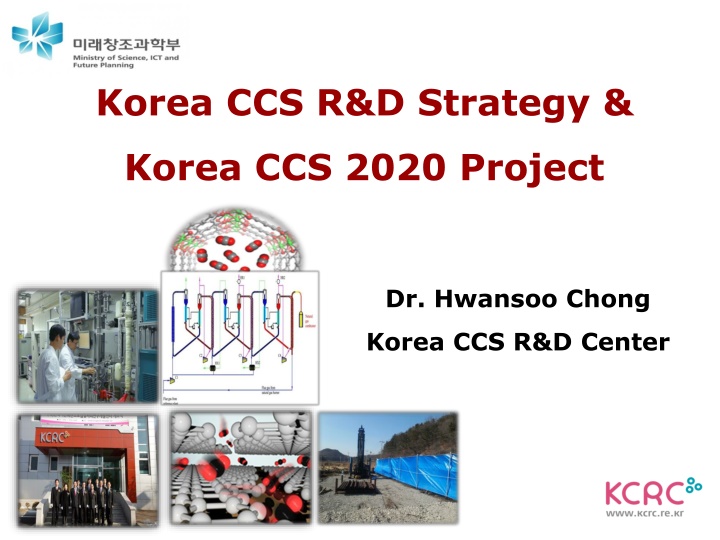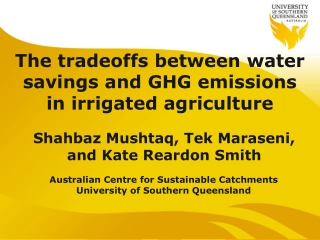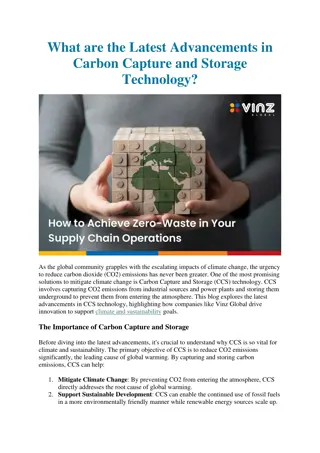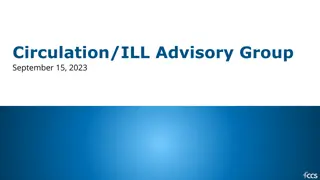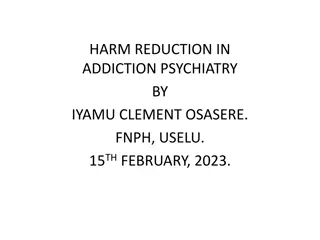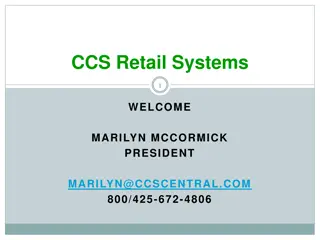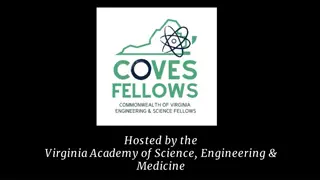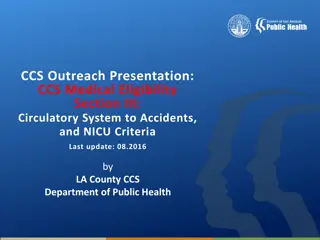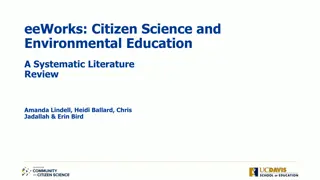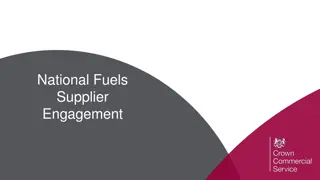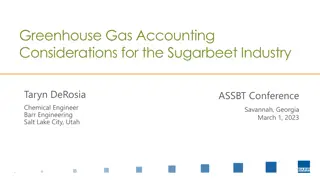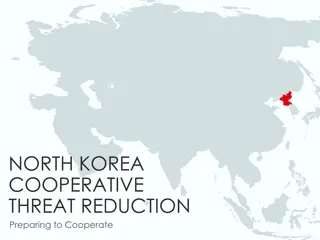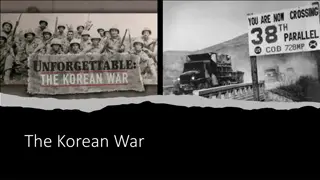Korea CCS R&D Strategy and National GHG Reduction Goals
This content discusses Korea's CCS R&D strategy, the National CCS 2020 project, and the country's goals for reducing greenhouse gas emissions. It highlights the importance of low carbon, green growth initiatives and outlines initiatives to achieve GHG reduction targets through innovative technologies and early deployment of CCS systems.
Download Presentation

Please find below an Image/Link to download the presentation.
The content on the website is provided AS IS for your information and personal use only. It may not be sold, licensed, or shared on other websites without obtaining consent from the author.If you encounter any issues during the download, it is possible that the publisher has removed the file from their server.
You are allowed to download the files provided on this website for personal or commercial use, subject to the condition that they are used lawfully. All files are the property of their respective owners.
The content on the website is provided AS IS for your information and personal use only. It may not be sold, licensed, or shared on other websites without obtaining consent from the author.
E N D
Presentation Transcript
Korea CCS R&D Strategy & Korea CCS 2020 Project Dr. Hwansoo Chong Korea CCS R&D Center
Presentation Outline National CCS R&D Plan I Korea CCS 2020 Project II Korea CCS R&D Center III
Low Carbon, Green Growth Serious Situation with Global Warming & Climate Change Need New Growth Engine for Economic Take-off Rapid Growth Trend of Green Industry Sector Respond to International Effort to reduce Greenhouse Gas Emissions Current administration presents Low Carbon & Green Growth as a new National Vision
GHG Reduction Goal of Korea Announced mid-term GHG Reduction Goal (19 Nov., 2009) Anticipative Measure Voluntary Reduction Goal Reduce GHG by 244 mil. tons Reduce 30% of BAU by 2020 Unit : million tone CO2 813 BAU Major Means for Reduction 594 30% - Supply next generation Green Car such as electric car and fuel cell car - Expand supply of state-of-the-art high efficiency products - Accerelate CCS Early Deployment 569 298 1990 2005 2020 5
How to Reduce GHG? Reduction Goal by Sector (%) Conversion (Power Generation) Agriculture, Forestry & Fisheries Country as a whole Industry Transport Building Wastes Public & others 18.2 26.7 34.3 26.9 5.2 12.3 25 30 Reduction Goal by year 850,000 800,000 750,000 -10% 700,000 -30% 650,000 BAU BAU After reduction 600,000 550,000 500,000 2010 2011 2012 2013 2014 2015 2016 2017 2018 2019 2020 Total national emission will reach maximum in 2014, and from 2015 emission will start to be abated to realize the decoupling of economic growth and greenhouse gas emission 6
Objectives & Implementation Tasks In July 2010, National CCS RD&D Plan was established for development of innovative CCS technologies and the promotion of commercialization Commercialization of plant and securing of international competitiveness for CCS technology by 2020 ( )100 - - - Demonstration of 1Mt-CO2integrated capture and storage systems (Select one or two domestic CO storage sites by 2015) - Development of original technology for CCS cost below $30/t CO (Capture: Below $20/t CO2 / Transport-Storage: Below $10/t CO ) Objective Advancement of R&D to develop innovative and core technology Promotion of early deployment and commercialization Development of whole cycle in management of environment & commercialization Implemen- tation Tasks 7
CCS RD&D Roadmap 2010 2015 2020 Capture 3rdGeneration Tech. Verification (0.5MW level) Development of 3rdGeneration Capture Tech. (Capture cost: 10~20$/tCO2) 2ndGeneration Tech. Develop 0.5MW level) Technology Development Transport. Storage Integrated research for Capture-Transport-Storage (0.5MW, 10,000t level) Following-up Control & Safety Evaluation Tech. Cost Reduction (linked to Demonstration) Basic Base Research Development of Innovative Storage Tech. (Transport Storage cost: 10$/ tCO2) Conversion Tech. Verification Biological Conversion & Use tech. dev. Basic Base Research Tech. Verification Chemical Conversion & Use tech. dev. Large scale Demonstration Post-combustion pilot plant (10~30MW) Integration of Capture- Transport-Storage (100~300MW, 1 Mt level) Demonstration Pre & Oxy- combustion pilot plant (10~30MW) Integration of Capture- Transport-Storage (100~300MW, 1 Mt level) Commercialization Storage site exploration Potential storage capacity evaluation & underground (land/marine) exploration Storage site construction & management Basic data Survey 8
Investment Plan Total investment for $ 2.6 billion from 2010 to 2019 (Government $ 1.4 billion (52%), Industry $ 1.2 billion (48%)) Environment Management & Base Establishment Core Technology Development Commercialization $ 263.6 million (10%) $ 2.1 billion (79%) $ 286.3 million (10%) Demonstration of large scale capture technology Development of whole cycle in environmental management Development of CO2 capture technology Development of conversion technology Survey on storage site Enhancement of Public acceptance Integrated research on capture & storage Demonstration of large scale storage Education and Training Company participation: Proof of large scale capture (Gov. 20%, Company 80%), Proof of large scale storage (Gov. - 60%, Company 40%) 9
Role by the Ministry (Capture) Develop core technologies, demonstrate small scale projects less than 0.5MW (Storage) Develop core technologies connected with capture, small scale demonstration of less than 10,000 tons (Conversion) Develop next-generation biological and chemical conversion technology MSIP (Ministry of Science, ICT and Future Planning) (Capture) Develop core technologies aimed at commercialization, carry out medium to large scale demonstration of over 0.5MW (Exploration) Land and underground exploration, provide exploration data of the Ministries concerned through KNOC (Storage) Develop core technologies for commercialization connected to capture, medium scale demonstration of over 10,000 tons MOTIE (Ministry of Trade, Industry & Energy) (Capture) Jointly participate in land and underground exploration and evaluation of other Ministries (Environmental protection DB establishment) (Conversion) Fix CO2emitted from environment facilities, fix CO2using wastes (Storage) Prevent CO2 leakage at the time of storing underground, develop monitoring and harmfulness evaluation technology and demonstrate it (Joint implementation with MSIP & MOTIE) ME (Ministry of Environment) MOF (Exploration) Carry out marine & underground exploration and evaluation (Storage) Prevent CO2 leakage at the time of storing at offshore underground, develop monitoring and harmfulness evaluation technology and demonstrate at offshore underground (Joint implementation with MOTIE) (Ministry of Oceans and Fisheries) 10
Strategies & Platform MSIP (CCS R&D Center) (Dec 22 2011) - Core Research & Network - Analyze technology trends & Play roles of CCS think-tank National CCS R&D Network ME/MOF (CCS Environment Center) MOTIE (CCS Association) (Nov 22 2010) - Control, license and permission related matters - Law and system related matters - Industry Cooperation Group - Commercialization & Promotion of Industry 11
Overview Project Overview (Period) Nov. 1, 2011~May 31, 2020 (Approx. 9 years) (Budget) Total $151 million (Support Tasks) 54 tasks (Participating Institutions) 39 institutions, universities and corporates including KIER, KRICT, KIST, Seoul National University, Korea University, Yonsei University, KAIST, Univ. of Texas, Univ. of California at Berkeley (Participants) Approx. 650 researchers with master and doctorate degrees Project Objective Securing leading CCS technology in the world through the development of innovative original CCS technology (Capture) Securing of more than 4 kinds of original technology for 3rd-generation CO2 capture within 30% of power generation cost increase rate (US$ 20/tCO2level as of 2010) by 2020 (Storage) Completion of CCS technology through the implementation of CO2 capture- storage integration project (Conversion) Securing of more than 2 kinds of original technology for CO2 conversion and use that are applicable to massive CO2 sequestration (Base Creation) Establishment of Think-tank platform center through CCS base creation 13
Roadmap for Technology Development 1stStage ( 11- 13) 2ndStage( 14- 16) 3rdStage( 17- 19) New CCS CCS Lab. Scale technology development (lab scale dev.) Massive emission source pilot scale proof (pilot development) technology concept proof (proof of concept) Final Goal Proof of more than 4 kinds of innovative capture technology through new materials compounding and process modeling Proof of bench scale for more than 4 kinds of CO2 capture technology (1Nm3/h scale) Secure economic analysis data Proof of prototype for actual environment of CO2 capture technology (100~2,000 Nm3/h scale) Develop more than 4 kinds of CO2 capture technology that can be licensed Capture Proof of CO2Storage possibility at Korea Peninsula stratum & secure storage technology Develop more than 2 kinds of CO2 conversion technology for massive sequestration Establish design & engineering technology before CO2injection Establish CO2injection & operation technology Establish management technology after CO2injection Storage Proof of more than 4 kinds of organic/inorganic conversion technology for CO2 Proof of bench scale for organic/inorganic conversion technology for CO2 Pilot proof of more than 2 kinds of organic/inorganic conversion technology for CO2 Conversion Establish initial R&D Management/Support System for Project team Reinforce outcome management of Project team and maintain R&D base Establish CCS R&D base of global level Establish CCS Think-tank platform center Base Technology development will be systematically implemented based on Level & Gate System starting from Proof of concept for technology (TRL3) stage to Proof of actual environment pilot (TRL6) stage. 14
PRESENT History 2014 June : Start 2ndStage 1stperiod of Korea CCS 2020 Project 2013 June : Start 1stStage 3rdperiod of Korea CCS 2020 Project June : Start 1stStage 2ndperiod of Korea CCS 2020 Project 2012 January : Open KCRC November : Start 1stStage 1stperiod of Korea CCS 2020 Project 2011 September : Select Korea CCS 2020 Project 2008 April : 3rdStage of CDRS Project Started 2005 April : 2ndStage of CDRS Project Started 2002 July : Establishment of the CDRS October : 1stStage of CDRS Project Started PAST
KCRCs Mission Leads and coordinates a program of underpinning research on all POST-CO2 CAPTURE aspects of CCS in support of basic science and Korea Government efforts on energy and climate change Korea government-funded CCS R&D Center - Conduct CCS R&D for the benefit of the public - Develop CCS technologies with collaboration of universities, institutes, and industry National CCS focal point & think-tank - Build a global network where academics, industry, regulators and other stakeholders collaborate to analyze problems, carry out world-leading research, and share knowledge
Mission Into Plan (8 targets Needed To Achieve 1 goal) Develop CCS National R&D Strategy and Policy Educate Graduate & Undergraduate Students Develop innovative CCS technologies Build CCS Public Acceptance Manage CCS R&D Project Perform IPR-Based Technology Transfers Enhance International Collaboration Publish Issue Reports Related to CCS& Energy Set-up Globalized Test Platform & Protocol 18
Commitment to Objectivity Together with research groups affiliated with our center we apply stringent standards of objectivity in performing CCS R&D Be achieved through our advisory committee and through world-class researchers from independent research and technical authorities from around the world Innovation We incorporate unique combinations of scientific discovery, creative and adaptive application, accidental insight and experience gained in the real world. Be committed to driving innovation through collaborative research and the effective application of results Result We produce a variety of products that range from advanced post-combustion CO2 capture technologies, papers, patents, newsletters, comprehensive reports, to research guideline to shape the robust future in CCS Secure resources for the next greatest innovation in energy and environment 19
Roles and Activities Developing innovative technology - Secure over 4 types of core CO2 tech. (3rdgeneration) - Demonstrate first CO2 capture-transport-storage integration system - Develop over 2 innovative tech. for CO2 conversion for large emitters Think tank in CCS-Energy-Environment Planning and management of R&D and outcomes Set-up a test and optimization platform - Build solvent/sorbent/ membrane-based CO2 capture plant linked to a coal-fired power plant - Establish analysis system for environment safety and develop material performance - Set-up CCS big data system
